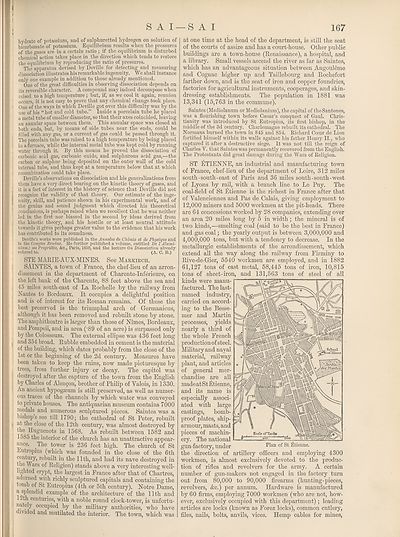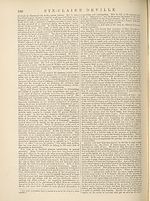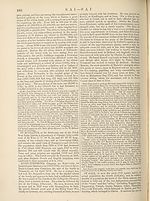Encyclopaedia Britannica > Volume 21, ROT-Siam
(177) Page 167
Download files
Complete book:
Individual page:
Thumbnail gallery: Grid view | List view

S A I —S A I
hydrate of potassium, and of sulphuretted hydrogen on solution of
bicarbonate of potassium. Equilibrium results when the pressures
of the gases are in a certain ratio ; if the equilibrium is disturbed
chemical action takes place in the direction which tends to restore
the equilibrium by reproducing the ratio of pressures.
The apparatus devised by Deville for detecting and measuring
dissociation illustrates his remarkable ingenuity. We shall instance
only one example in addition to those already mentioned.
One of the great difficulties in observing dissociation depends on
its reversible character. A compound may indeed decompose when
raised to a high temperature ; but, if, as we cool it again, reunion
occurs, it is not easy to prove that any chemical change took place.
One of the ways in which Deville got over this difficulty was by the
use of his “hot and cold tube.” Inside a porcelain tube he placed
a metal tube of smaller diameter, so that their axes coincided, leaving
an annular space between them. This annular space was closed at
both ends, but, by means of side tubes near the ends, could be
Idled with any gas, or a current of gas could be passed through it.
The porcelain tube was raised to a high temperature by being placed
in a furnace, while the internal metal tube was kept cold by running
water through it. By this means he proved the dissociation of
carbonic acid gas, carbonic oxide, and sulphurous acid gas,—the
carbon or sulphur being deposited on the outer wall of the cold
internal tube, and thus kept at a temperature below that at which
recombination could take place.
Deville’s observations on dissociation and his generalizations from
them have a very direct bearing on the kinetic theory of gases, and
it is a fact of interest in the history of science that Deville did not
recognize the validity of that theory. Our estimate of the inge¬
nuity, skill, and patience shown in his experimental work, and of
the genius and sound judgment which directed his theoretical
conclusions, is perhaps raised when we recollect that he was neither
led in the first nor biassed in the second by ideas derived from
the kinetic theory, and his hostile or at least neutral attitude
towards it gives perhaps greater value to the evidence that his work
has contributed to its soundness.
Deville’s works were published in the Annales de Chimie et de Physique and
in the Comptes Bendus. He further published a volume, entitled De VAlumi¬
nium; ses Proprietes, &c., Paris, 1859, and the lecture On Dissociation already-
referred to. (A. C. B.)
STE MARIE-AUX-MINES. See Markirch.
SAINTES, a town of France, the chef-lieu of an arron-
dissement in the department of Charente-Inferieure, on
the left bank of the Charente, 88 feet above the sea and
45 miles south-east of La Rochelle by the railway from
Nantes to Bordeaux. It occupies a delightful position
and is of interest for its Roman remains. Of these the
best preserved is the triumphal arch of Germanicus,
although it has been removed and rebuilt stone by stone.
The amphitheatre is larger than those of Nimes, Bordeaux,
and Pompeii, and in area (’89 of an acre) is surpassed only
by the Colosseum. The external ellipse was 436 feet long
and 354 broad. Rubble embedded in cement is the material
of the building, which dates probably from the close of the
1st or the beginning of the 2d century. Measures have
been taken to keep the ruins, now made picturesque by
trees, from further injury or decay. The capitol was
destroyed after the capture of the town from the English
by Charles of Alen^on, brother of Philip of Valois, in 1330.
An ancient hypogseum is still preserved, as well as numer¬
ous traces of the channels by which water wms conveyed
to private houses. The antiquarian museum contains 7000
medals and numerous sculptured pieces. Saintes was a
bishop’s see till 1790; the cathedral of St Peter, rebuilt
at the close of the 12th century, was almost destroyed by
the Huguenots in 1568. As rebuilt between 1582 and
1585 the interior of the church has an unattractive appear¬
ance. The tower is 236 feet high. The church of St
Eutropius (which was founded in the close of the 6th
century, rebuilt in the 11th, and had its nave destroyed in
the Wars of Religion) stands above a very interesting well-
ighted crypt, the largest in France after that of Chartres,
adorned with richly sculptured capitals and containing the
tomb of St Eutropius (4th or 5th century). Notre Dame,
a splendid example of the architecture of the 11th and
-th centuries, with a noble round clock-tower, is unfortu-
nately occupied. by the military authorities, who have
t n ided and mutilated the interior. The town, which wras
167
at one time at the head of the department, is still the seat
of the courts of assize and has a -court-house. Other public
buildings are a town-house (Renaissance), a hospital, and
a library. Small vessels ascend the river as far as Saintes,
which has an advantageous situation between Angouleme
and Cognac higher up and Taillebourg and Rochefort
farther down, and is the seat of iron and copper foundries,
factories for agricultural instruments, cooperages, and skin¬
dressing establishments. The population in 1881 was
13,341 (15,763 in the commune).
Saintes (Mediolanum or Mediolanium), the capital of the Santones,
was a flourishing town before Caesar’s conquest of Gaul. Chris¬
tianity was introduced by St Eutropius, its first bishop, in the
middle of the 3d century. Charlemagne rebuilt its cathedral. The
Normans burned the town in 845 and 854. Richard Coeur de Lion
fortified himself within its walls against his father Henry II., who
captured it after a destructive siege. It was not till the reign of
Charles V. that Saintes was permanently recovered from the English.
The Protestants did great damage during the Wars of Religion.
st Etienne, an industrial and manufacturing town
of France, chef-lieu of the department of Loire, 312 miles
south-south-east of Paris and 36 miles south-south-wmst
of Lyons by rail, with a branch line to Le Puy. The
coal-field of St Etienne is the richest in France after that
of Valenciennes and Pas de Calais, giving employment to
12,000 miners and 5000 workmen at the pit-heads. There
are 64 concessions worked by 28 companies, extending over
an area 20 miles long by 5 in width; the mineral is of
two kinds,—smelting coal (said to be the best in France)
and gas coal; the yearly output is between 3,000,000 and
4,000,000 tons, but with a tendency to decrease. In the
metallurgic establishments of the arrondissement, which
extend all the way along the railway from Firminy to
Rive-de-Gier, 5540 workmen are employed, and in 1882
61,127 tons of cast metal, 58,445 tons of iron, 10,815
tons of sheet-iron, and 131,563 tons of steel of all
kinds were manu¬
factured. The last-
named industry,
carried on accord¬
ing to the Besse¬
mer and Martin
processes, yields
nearly a third of
the whole French
production of steel.
Military and naval
material, railway
plant, and articles
of general mer¬
chandise are all
made at St Etienne,
and its name is
especially associ¬
ated with large
castings, bomb¬
proof plates, ship-
armour, masts, and
pieces of machin¬
ery. The national
gun-factory, under
the direction of artillery officers and employing 4300
workmen, is almost exclusively devoted to the produc¬
tion of rifles and revolvers for the army, A certain
number of gun-makers not engaged in the factory turn
out from 80,000 to 90,000 firearms (hunting-pieces,
revolvers, Ac.) per annum. Hardware is manufactured
by 60 firms, employing 7000 workmen (who are not, how¬
ever, exclusively occupied with this department) ; leading
articles are locks (known as Forez locks), common cutlery,
files, nails, bolts, anvils, vices. Hemp cables for mines,
Plan of St Etienne.
hydrate of potassium, and of sulphuretted hydrogen on solution of
bicarbonate of potassium. Equilibrium results when the pressures
of the gases are in a certain ratio ; if the equilibrium is disturbed
chemical action takes place in the direction which tends to restore
the equilibrium by reproducing the ratio of pressures.
The apparatus devised by Deville for detecting and measuring
dissociation illustrates his remarkable ingenuity. We shall instance
only one example in addition to those already mentioned.
One of the great difficulties in observing dissociation depends on
its reversible character. A compound may indeed decompose when
raised to a high temperature ; but, if, as we cool it again, reunion
occurs, it is not easy to prove that any chemical change took place.
One of the ways in which Deville got over this difficulty was by the
use of his “hot and cold tube.” Inside a porcelain tube he placed
a metal tube of smaller diameter, so that their axes coincided, leaving
an annular space between them. This annular space was closed at
both ends, but, by means of side tubes near the ends, could be
Idled with any gas, or a current of gas could be passed through it.
The porcelain tube was raised to a high temperature by being placed
in a furnace, while the internal metal tube was kept cold by running
water through it. By this means he proved the dissociation of
carbonic acid gas, carbonic oxide, and sulphurous acid gas,—the
carbon or sulphur being deposited on the outer wall of the cold
internal tube, and thus kept at a temperature below that at which
recombination could take place.
Deville’s observations on dissociation and his generalizations from
them have a very direct bearing on the kinetic theory of gases, and
it is a fact of interest in the history of science that Deville did not
recognize the validity of that theory. Our estimate of the inge¬
nuity, skill, and patience shown in his experimental work, and of
the genius and sound judgment which directed his theoretical
conclusions, is perhaps raised when we recollect that he was neither
led in the first nor biassed in the second by ideas derived from
the kinetic theory, and his hostile or at least neutral attitude
towards it gives perhaps greater value to the evidence that his work
has contributed to its soundness.
Deville’s works were published in the Annales de Chimie et de Physique and
in the Comptes Bendus. He further published a volume, entitled De VAlumi¬
nium; ses Proprietes, &c., Paris, 1859, and the lecture On Dissociation already-
referred to. (A. C. B.)
STE MARIE-AUX-MINES. See Markirch.
SAINTES, a town of France, the chef-lieu of an arron-
dissement in the department of Charente-Inferieure, on
the left bank of the Charente, 88 feet above the sea and
45 miles south-east of La Rochelle by the railway from
Nantes to Bordeaux. It occupies a delightful position
and is of interest for its Roman remains. Of these the
best preserved is the triumphal arch of Germanicus,
although it has been removed and rebuilt stone by stone.
The amphitheatre is larger than those of Nimes, Bordeaux,
and Pompeii, and in area (’89 of an acre) is surpassed only
by the Colosseum. The external ellipse was 436 feet long
and 354 broad. Rubble embedded in cement is the material
of the building, which dates probably from the close of the
1st or the beginning of the 2d century. Measures have
been taken to keep the ruins, now made picturesque by
trees, from further injury or decay. The capitol was
destroyed after the capture of the town from the English
by Charles of Alen^on, brother of Philip of Valois, in 1330.
An ancient hypogseum is still preserved, as well as numer¬
ous traces of the channels by which water wms conveyed
to private houses. The antiquarian museum contains 7000
medals and numerous sculptured pieces. Saintes was a
bishop’s see till 1790; the cathedral of St Peter, rebuilt
at the close of the 12th century, was almost destroyed by
the Huguenots in 1568. As rebuilt between 1582 and
1585 the interior of the church has an unattractive appear¬
ance. The tower is 236 feet high. The church of St
Eutropius (which was founded in the close of the 6th
century, rebuilt in the 11th, and had its nave destroyed in
the Wars of Religion) stands above a very interesting well-
ighted crypt, the largest in France after that of Chartres,
adorned with richly sculptured capitals and containing the
tomb of St Eutropius (4th or 5th century). Notre Dame,
a splendid example of the architecture of the 11th and
-th centuries, with a noble round clock-tower, is unfortu-
nately occupied. by the military authorities, who have
t n ided and mutilated the interior. The town, which wras
167
at one time at the head of the department, is still the seat
of the courts of assize and has a -court-house. Other public
buildings are a town-house (Renaissance), a hospital, and
a library. Small vessels ascend the river as far as Saintes,
which has an advantageous situation between Angouleme
and Cognac higher up and Taillebourg and Rochefort
farther down, and is the seat of iron and copper foundries,
factories for agricultural instruments, cooperages, and skin¬
dressing establishments. The population in 1881 was
13,341 (15,763 in the commune).
Saintes (Mediolanum or Mediolanium), the capital of the Santones,
was a flourishing town before Caesar’s conquest of Gaul. Chris¬
tianity was introduced by St Eutropius, its first bishop, in the
middle of the 3d century. Charlemagne rebuilt its cathedral. The
Normans burned the town in 845 and 854. Richard Coeur de Lion
fortified himself within its walls against his father Henry II., who
captured it after a destructive siege. It was not till the reign of
Charles V. that Saintes was permanently recovered from the English.
The Protestants did great damage during the Wars of Religion.
st Etienne, an industrial and manufacturing town
of France, chef-lieu of the department of Loire, 312 miles
south-south-east of Paris and 36 miles south-south-wmst
of Lyons by rail, with a branch line to Le Puy. The
coal-field of St Etienne is the richest in France after that
of Valenciennes and Pas de Calais, giving employment to
12,000 miners and 5000 workmen at the pit-heads. There
are 64 concessions worked by 28 companies, extending over
an area 20 miles long by 5 in width; the mineral is of
two kinds,—smelting coal (said to be the best in France)
and gas coal; the yearly output is between 3,000,000 and
4,000,000 tons, but with a tendency to decrease. In the
metallurgic establishments of the arrondissement, which
extend all the way along the railway from Firminy to
Rive-de-Gier, 5540 workmen are employed, and in 1882
61,127 tons of cast metal, 58,445 tons of iron, 10,815
tons of sheet-iron, and 131,563 tons of steel of all
kinds were manu¬
factured. The last-
named industry,
carried on accord¬
ing to the Besse¬
mer and Martin
processes, yields
nearly a third of
the whole French
production of steel.
Military and naval
material, railway
plant, and articles
of general mer¬
chandise are all
made at St Etienne,
and its name is
especially associ¬
ated with large
castings, bomb¬
proof plates, ship-
armour, masts, and
pieces of machin¬
ery. The national
gun-factory, under
the direction of artillery officers and employing 4300
workmen, is almost exclusively devoted to the produc¬
tion of rifles and revolvers for the army, A certain
number of gun-makers not engaged in the factory turn
out from 80,000 to 90,000 firearms (hunting-pieces,
revolvers, Ac.) per annum. Hardware is manufactured
by 60 firms, employing 7000 workmen (who are not, how¬
ever, exclusively occupied with this department) ; leading
articles are locks (known as Forez locks), common cutlery,
files, nails, bolts, anvils, vices. Hemp cables for mines,
Plan of St Etienne.
Set display mode to:
![]() Universal Viewer |
Universal Viewer | ![]() Mirador |
Large image | Transcription
Mirador |
Large image | Transcription
Images and transcriptions on this page, including medium image downloads, may be used under the Creative Commons Attribution 4.0 International Licence unless otherwise stated. ![]()
| Encyclopaedia Britannica > Encyclopaedia Britannica > Volume 21, ROT-Siam > (177) Page 167 |
|---|
| Permanent URL | https://digital.nls.uk/193629580 |
|---|
| Attribution and copyright: |
|
|---|---|
| Shelfmark | EB.17 |
|---|---|
| Description | Ten editions of 'Encyclopaedia Britannica', issued from 1768-1903, in 231 volumes. Originally issued in 100 weekly parts (3 volumes) between 1768 and 1771 by publishers: Colin Macfarquhar and Andrew Bell (Edinburgh); editor: William Smellie: engraver: Andrew Bell. Expanded editions in the 19th century featured more volumes and contributions from leading experts in their fields. Managed and published in Edinburgh up to the 9th edition (25 volumes, from 1875-1889); the 10th edition (1902-1903) re-issued the 9th edition, with 11 supplementary volumes. |
|---|---|
| Additional NLS resources: |
|

